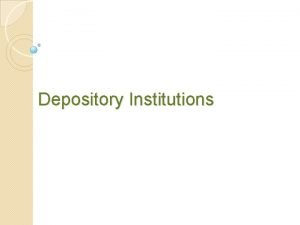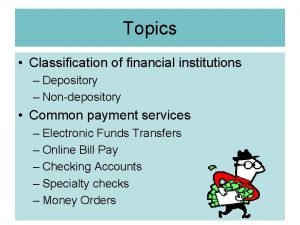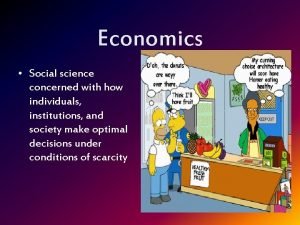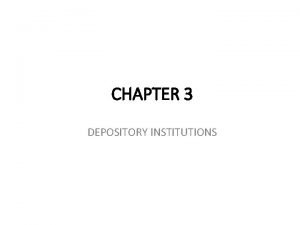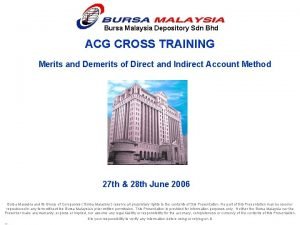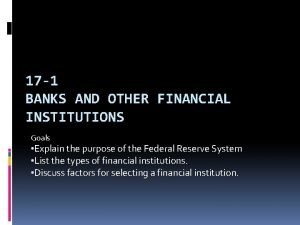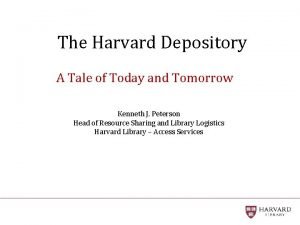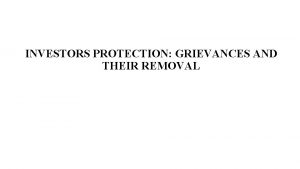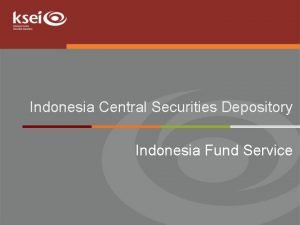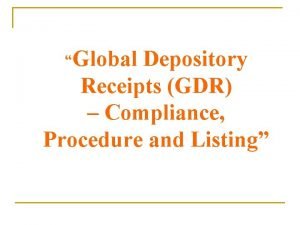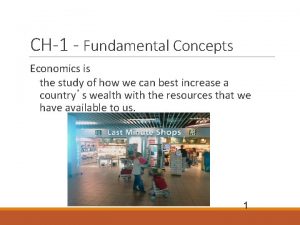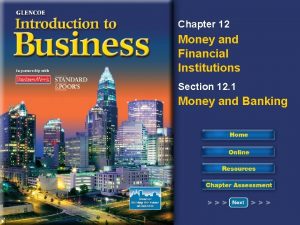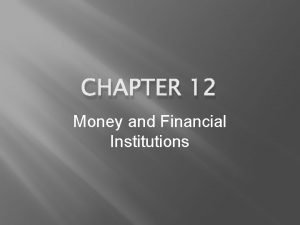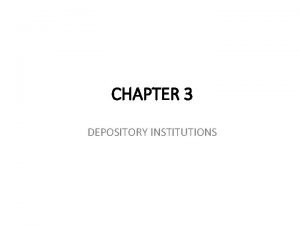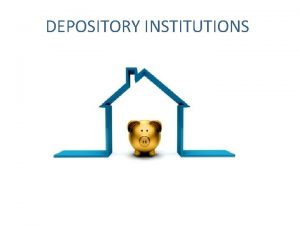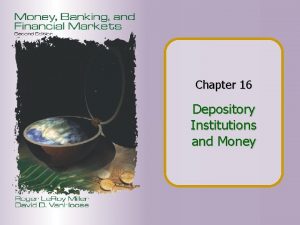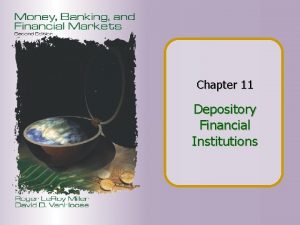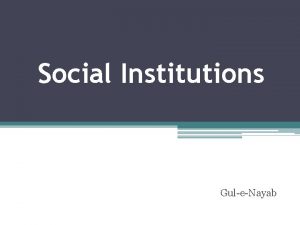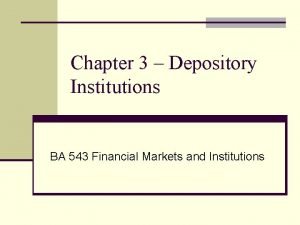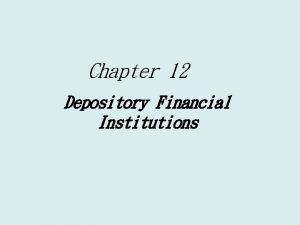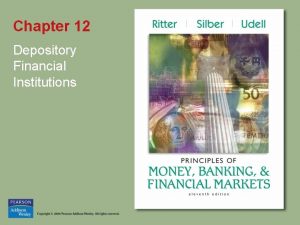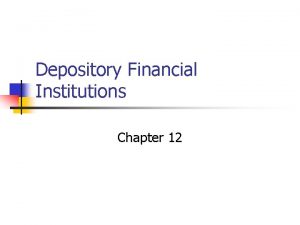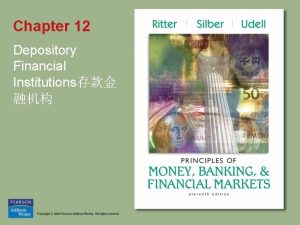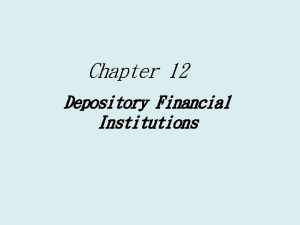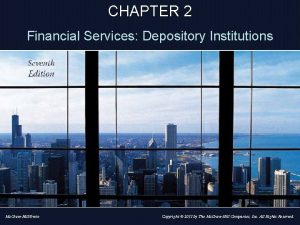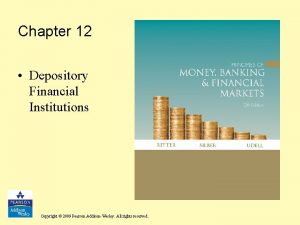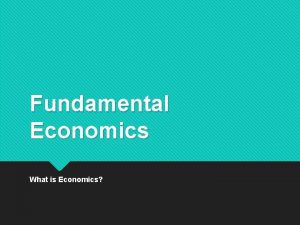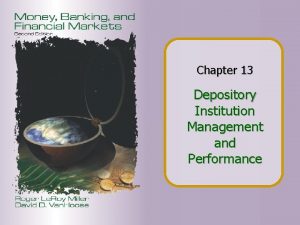Chapter 12 The Economics of Depository Institutions Fundamental






















- Slides: 22

Chapter 12 The Economics of Depository Institutions

Fundamental Issues 1. In the basic economic theory of banking markets, what are the sources of bank revenues and costs? 2. What are the loan supply and deposit demand schedules for perfectly competitive banks? 3. How are bank loan and deposit rates determined in perfectly competitive banking markets? 4. How is the interest rate on bank loans determined in a monopoly loan market? Copyright © 2004 South-Western. All rights reserved. 2

The Bank Balance Sheet • Balance-sheet constraint: Ø The accounting constraint that a bank’s assets cannot exceed the sum of its liabilities and net worth. • Real resource expenses: Ø Expenses that a bank must incur in the form of explicit payments of wages and salaries to employees, explicit payments to other owners of factors of production, and opportunity costs of devoting resources of the bank’s owners to that line of business rather than an alternative. Copyright © 2004 South-Western. All rights reserved. 3

Bank Revenues, Costs, and Profits • Bank revenues: Ø A bank’s total interest earnings, or total revenues, on its total quantity of one-period loans must equal: • Bank costs: Ø Explicit interest expenses Ø Real resource expenses for deposits Ø Real resource expenses for loans Copyright © 2004 South-Western. All rights reserved. 4

Bank Revenues, Costs, and Profits • Bank profits: Ø A bank’s economic profits equal its total revenues less its total economic costs. Ø For the typical bank, profits equal loan interest revenues minus total economic costs—loan interest revenues less deposit expenses, real deposit resource costs, and real loan resource costs. Copyright © 2004 South-Western. All rights reserved. 5

Marginal Revenue • Marginal revenue (MR): Ø The gain in total revenues resulting from a one-unit increase in production of a good or service. Ø For a bank, the addition to its revenues from adding an additional dollar of loan assets. Copyright © 2004 South-Western. All rights reserved. 6

A Perfectly Competitive Bank’s Marginal Revenue Schedule Figure 12– 1 Copyright © 2004 South-Western. All rights reserved. 7

Marginal Cost • Marginal cost (MC): Ø The addition to the total cost generated by a oneunit increase in production of a good or service. Ø For a bank, the addition to total cost from obtaining an additional dollar of deposits to lend, which is the sum of marginal deposit interest expense, marginal deposit resource costs, and marginal loan resource costs. Copyright © 2004 South-Western. All rights reserved. 8

Marginal Cost for a Perfectly Competitive Bank Figure 12– 2 Copyright © 2004 South-Western. All rights reserved. 9

Profit-Maximizing Lending at a Perfectly Competitive Bank Figure 12– 3 Copyright © 2004 South-Western. All rights reserved. 10

A Perfectly Competitive Bank’s Loan Supply Schedule Figure 12– 4 Copyright © 2004 South-Western. All rights reserved. 11

The Profit-Maximizing Deposit Level Figure 12 – 5 Copyright © 2004 South-Western. All rights reserved. 12

A Perfectly Competitive Bank’s Deposit Demand Schedule Figure 12– 6 Copyright © 2004 South-Western. All rights reserved. 13

The Market Loan Supply Schedule Figure 12– 7 Copyright © 2004 South-Western. All rights reserved. 14

Equilibrium in a Perfectly Competitive Loan Market Figure 12– 8 Copyright © 2004 South-Western. All rights reserved. 15

Effects of a Decrease in the Nonbank Public’s Demand for Loans Figure 12– 9 Copyright © 2004 South-Western. All rights reserved. 16

The Market Deposit Demand Schedule Figure 12– 10 Copyright © 2004 South-Western. All rights reserved. 17

Equilibrium in a Perfectly Competitive Deposit Market Figure 12– 11 Copyright © 2004 South-Western. All rights reserved. 18

Imperfect Competition in Banking? • Imperfectly competitive market: Ø A market in which conditions for perfect competition, such as freedom of entry and exit, fail to hold, so banks can set their own loan or deposit rates to maximize their individual profits. • Monopoly: Ø A market environment in which only a single firm, or a group of firms collectively coordinating their actions, produces a good or service; in banking, a situation in which only one bank or a coordinating group of banks lends and takes in deposits. Copyright © 2004 South-Western. All rights reserved. 19

Effects of a Decrease in the Nonbank Public’s Supply of Deposits Figure 12– 12 Copyright © 2004 South-Western. All rights reserved. 20

A Monopoly Loan Market Figure 12– 13 Copyright © 2004 South-Western. All rights reserved. 21

Index Measures of Interest Rates Offered on Online Bank Deposits SOURCE: ffice of the Comptroller of the Currency. Copyright © 2004 South-Western. All rights reserved. Figure 12– 14 22
 Depository institutions include
Depository institutions include Endorse a check to someone else
Endorse a check to someone else Economics is concerned with how individuals institutions
Economics is concerned with how individuals institutions Depository institution
Depository institution Bursa malaysia depository sdn bhd
Bursa malaysia depository sdn bhd Depository institution
Depository institution Harvard depository
Harvard depository Misr clearing settlement central depository
Misr clearing settlement central depository Complaint against depository participant
Complaint against depository participant S-invest indonesia
S-invest indonesia Global depository receipts
Global depository receipts Identify the five fundamental questions that all economies
Identify the five fundamental questions that all economies Fundamental concept
Fundamental concept Discounting principle in managerial economics
Discounting principle in managerial economics The fundamental concept of economics is
The fundamental concept of economics is Maastricht university school of business and economics
Maastricht university school of business and economics Econ213
Econ213 Why study financial markets?
Why study financial markets? Chapter 12 money and financial institutions
Chapter 12 money and financial institutions Chapter 12 money and financial institutions
Chapter 12 money and financial institutions Hát kết hợp bộ gõ cơ thể
Hát kết hợp bộ gõ cơ thể Frameset trong html5
Frameset trong html5 Bổ thể
Bổ thể
